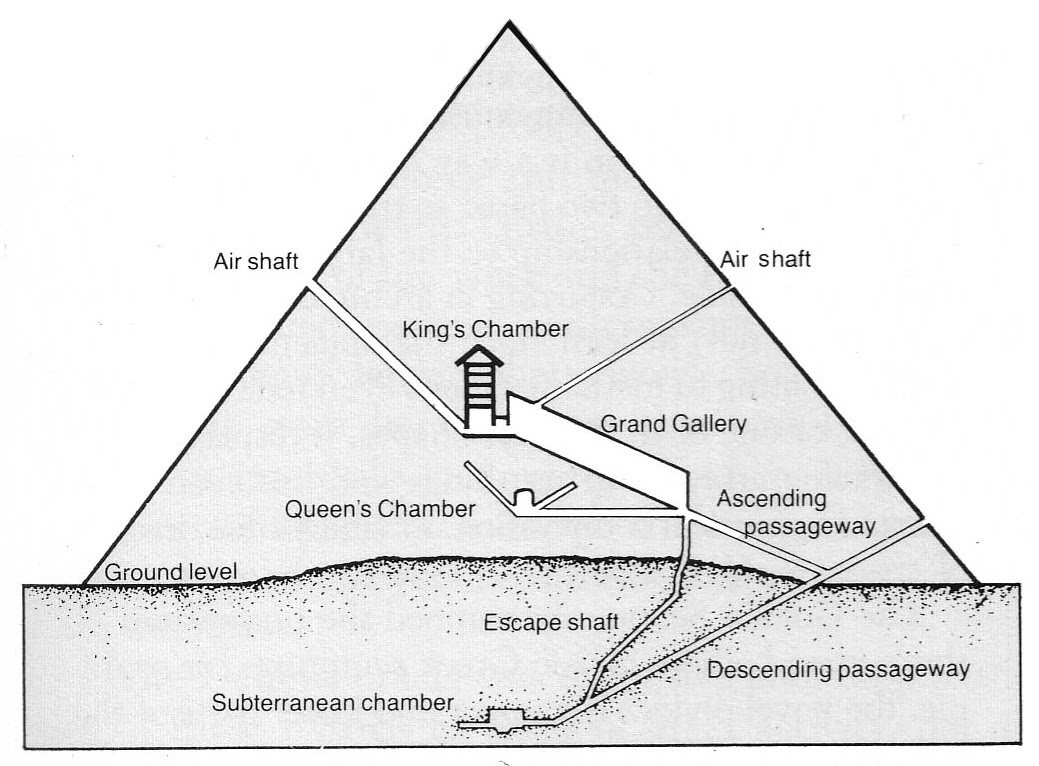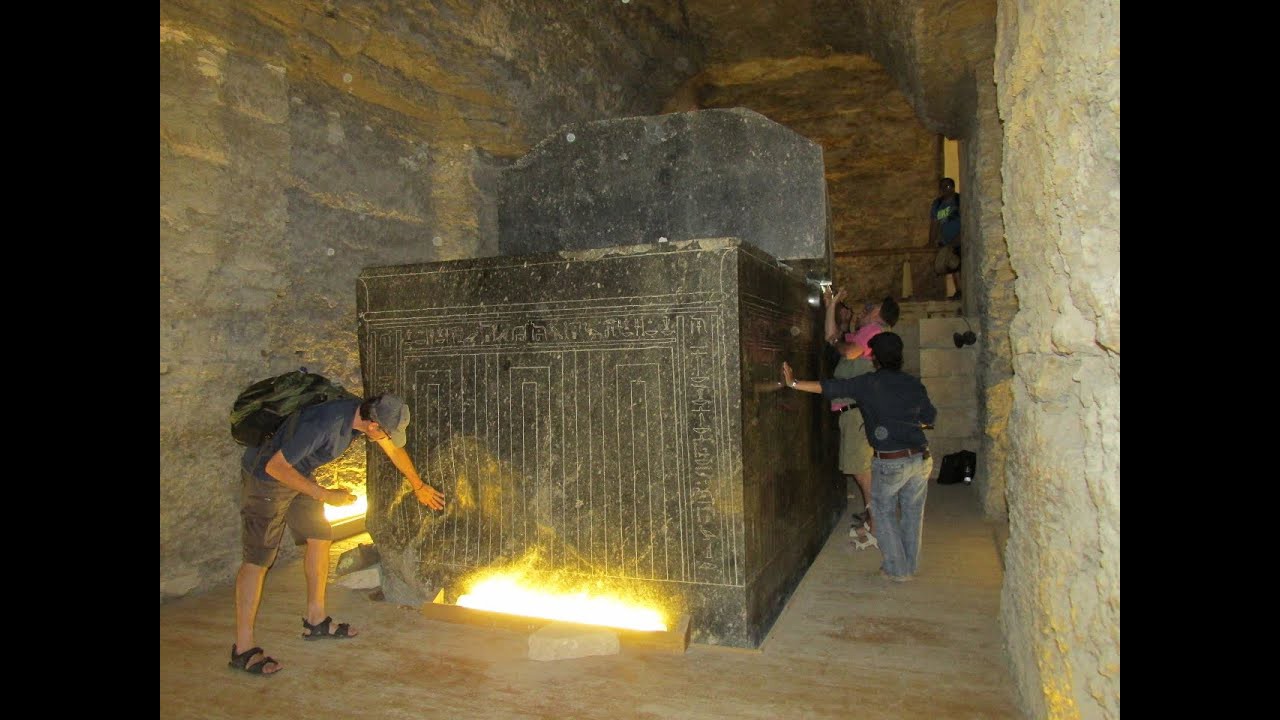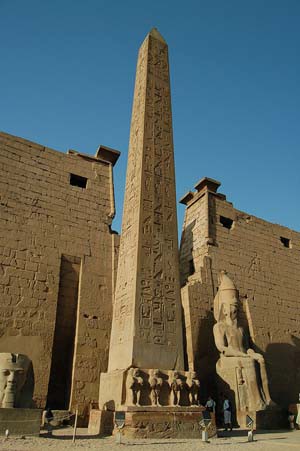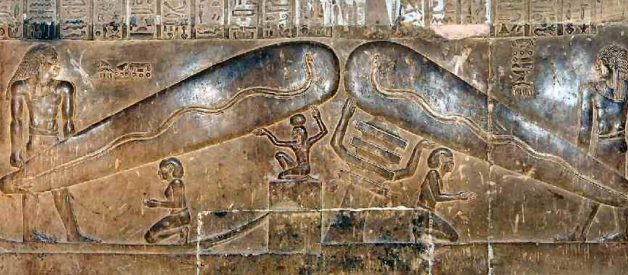 Interior Diagram of the Great Pyramid at Giza
Interior Diagram of the Great Pyramid at Giza
The most commonly accepted theory is that the Great Pyramid at Giza was a tomb for the fourth dynasty Egyptian Pharoah Khufu or Cheops (two different versions of the same name).
However, there are a disturbing number of features about the Great Pyramid that this theory doesn?t account for. The first and most obvious being that the Great Pyramid doesn?t contain any of the things a real Egyptian tomb would, such as extravagant artifacts; ornate wall art; sealed entrances; elaborate coffins; or even mummies.
It would have taken 20 years to build the Great Pyramid using at least 20,000 workers, working all day, every day, using ramps, ropes and pulleys (as conventionally hypothesized). However, this hypothesis remains just that: a hypothesis ? it?s never been proven. But even if it?s true, how could a resting place for the dead warrant such phenomenal time, effort and precise engineering?
The pyramid contains angled tunnels that lead not only into the pyramid, but deep underground, into areas as yet unexplored. What tomb needs a shaft directed underneath it?
We also know that centuries ago, there were enormous swivel doors that weighed no less than 20 tons. But miraculously, they were so well engineered they could be opened by the push of a hand. Since no Egyptian tomb has been found to be deliberately accessible, what were the pyramids for?
The Great Pyramid of Giza was once covered in white polished limestone, referred to as casing stones. The stones fit together so perfectly, they would have given the pyramid, smooth, flawless sides. This would have made the giant structures brightly reflect the sun like a mirror. It also would have made the inside of the structure perfectly insulated.
A large earthquake in 1303 shattered many casing stones, and the remainder were removed to use on other structures. Today, all that remains is the inner core of the pyramid.
The material dolomite was used on the inner surfaces of the pyramid. Dolomite is known to increase electrical conductivity, directly relative to the amount of pressure on it: high pressure creates more electrical current.
Lining the passageways and underground tunnels of the pyramid is granite, which is slightly radioactive. Granite contains high amounts of quartz crystal with metal, and it?s a well-known conductor of piezo electricity.
Piezo electricity occurs as a result of stress or pressure on the quartz, as demonstrated by quartz wristwatches, which can be charged simply by shaking them.
The granite actually ionises the air inside the pyramid, creating a chemical reaction, which again, increases the conductivity of electricity. When such electrons are given the chance to bypass sections of rock via metal wire, quite large currents can flow.
If granite was not chosen for its electrical conductivity, we must ask, why else would the Egyptians use it? It has certainly stood the test of time, no matter which version of history you believe: the conventional one, that says it was built 4,500 years ago; or unconventional versions, which say it could be as old as 20, 000 years! Still, the amount of work involved beggars the imagination: granite is one of the hardest stones on Earth, so working it would?ve taken at least 10 times as long as building the Pyramid out of limestone, as they did the Sphinx. Limestone was also a more logical choice, because it was abundant on the Giza Plateau. It is thought that the granite used to make the Pyramid was brought in by boat from a quarry in Aswan 500 miles (800km) away. Wikipedia says 8,000 tons of granite were used in the Great Pyramid. That?s an awful lot of very long boat trips! Additionally, the Pyramid is estimated to be made of 2.3 million blocks, which would have meant installing 800 tons of stone every day, to complete it in 20 years. Put another way, it would have meant putting an average of 12 blocks in place (each block weighing between 25?80 tons) every hour, day and night, for 20 years. Do you really think the Egyptians would go to so much effort just to build a tomb that would last forever?
Just northwest of the Great Pyramid is the Serapeum. Here there are 20 huge granite boxes, each weighing 100 tons. Classic Egyptologists say these are coffins ? LOL! Yet, the granite here came from 500 miles away, and each box is so huge and heavy, it couldn?t possibly fit through the existing tunnels and entrances.
These supposed sarcophagi were therefore somehow built into the structure with such precision, they?re within a ten thousandth of an inch of being perfectly flat.
Since the supposed Sarcophagi are way too large for a human being, the accepted theory is that they were coffins for the Pharoah?s prize bulls ? LOL! Sounds like a lot of bull to me? who?d go to all that trouble just to make coffins for bulls?
 One of the supposed sarcophagi in the Serapeum
One of the supposed sarcophagi in the Serapeum
Any electrical engineer will tell you that a container serving as an energy capacitor or battery, must be made entirely of the same substance, so there?s no interruption in the magnetic field. There?s a centuries old granite sarcophagus on display in an Egyptian museum, that?s thought to be unfinished. However, unlike those in the pyramids, this one?s cracked; suggesting it wasn?t unfinished, merely abandoned, since the crack would have interrupted the magnetic field.
In 1993, a mysterious and inaccessible room was discovered after remaining hidden for thousands of years. Appearing to have been deliberately concealed by the structure?s engineers, the room came to be called the Queen?s chamber and was finally explored in 2011 with a small remote camera to reveal a carefully crafted copper wire. More importantly, there were instructions painted as symbols onto the floor which appeared to show a clear wiring diagram.
Any battery, from those used in large power plants, to the smallest pellet batteries in wristwatches, requires a metal, such as copper, to create the chemical reaction known as potential difference. You can run an electric current through copper wire, and the coil will produce a short range magnetic field. Add second coil, and the power is transferred from one coil to the other.
A windowless room, with copper wirings, could create a higher potential on one wall, which transfers energy to the lower potential on the other wall, consequentially releasing electromagnetic energy into the confined space of the so-called ?Queen?s Chamber.?
Sadly, these wires have since disappeared entirely, and mainstream Egyptologists claim there?s no functionality to this room whatsoever; as they also claim there?s no functionality of anything in the pyramid, beyond the ways it serves as a tomb.
The foremost Egyptologist, Zahi Hawass, was indicted for theft of Egyptian antiquities in 2014. Although there was no evidence against Hawass, and he wasn?t formally charged, he is only one of many who could have stolen the copper wires from the Queen?s Chamber. The looting of ancient artifacts in an old problem in Egypt, but political instability has exacerbated the issue. A revolution in 2011 caused a breakdown in the police force, which gangs of artifact thieves were quick to take advantage of.
New technologies, including DigitalGlobe and Google Earth, are now used by the authorities to locate and monitor looting ?hot spots.? Yet the task remains herculean ? and many looters continue to go unnoticed.
It could still be argued that the electrical materials used to construct the great pyramid are purely coincidental, because an energy generator still requires a catalyst from another source. Perhaps this explains why the pyramids are geographically located over a powerful natural generator: underground rivers and aquifers. Piezo electricity could be harnessed from the power of the current as the water flows, and it has been proven that thousands of years ago, the Nile River ran straight past the pyramids.
This brings into debate the age of the pyramids themselves. The weathering on pyramids, and on the nearby Sphinx, indicates the monuments are actually double the age they?re currently assumed to be. Perhaps this explains why there?s no mention of the pyramids or their creation in any of the Egyptian writings.
So if water was the source of power, it would have travelled up the limestone based on the principle of capillary action, which happens when a small area of a substance that gets wet, absorbs into the entire area of that substance. The tunnel leading down from the bottom of the pyramid, could?ve tapped into an aquifer, channelling the water up into the pyramid, through a series of tunnels. So, water flowing near or underneath the pyramid could have been absorbed as it passed over the limestone, even travelling upward to the top of the structure. The quartz and the tunnels of the pyramids would be subject to the stress or vibration creating piezo electricity.
The high force speed and the pressure of the rising water would be analogous to filling a syringe, generating electromagnetic energy within the structure by the materials within it, and conducting it upwards to the now-missing capstone.
The Great Pyramid is located at the exact point which magnifies the electromagnetic forces on the planet where telluric currents are at their strongest. There?s an electromagnetic field at the bottom of the pyramid, which would rise to the upper layers with these chemical reactions.
We don?t know for sure what capped the pyramid, but there?s speculation that it may have been gold (explaining why it was the first thing to go missing). If it was indeed, gold, this could have created a conductive path for energy to be directed upwards, high into the ionosphere.
The Great Pyramid may in fact, have been a form of Tesla Tower, constructed ten thousand years or more before Nikola Tesla built his own Tower, in 1903. Tesla claimed that at 30, 000 feet altitude, there?s a stratum of rarefied air that would conduct electric currents at high voltages. In this proposed system, there was a transmitter (Tesla Tower), which would transmit millions of volts into the atmosphere. Then he had something (a rod in the ground, with a few special modifications) that would receive the energy and reduce the voltage to a potential that could be used by consumers.
Unfortunately, Tesla?s work was funded by J.P. Morgan, who was an oil and gas tycoon, who dominated the electricity industry in the 1900s. Morgan correctly saw Tesla?s Tower as a threat to his business (as it would have meant free electricity for everyone), and used all of his money and influence to ruin Tesla.
We?ve seen induction work between copper wires over a short distance. For a long distance transfer, the same principle can be applied when acoustic energy is converted to kinetic energy, and the frequencies match. We see this in practice when an opera singer shatters a glass with their voice: the frequency of the singer?s voice matches the resonant frequency of the glass and the acoustic energy is converted into kinetic energy. So if there?s a magnetically oscillating current, and you create a second, possessing the same frequency, the wireless transmission can pass through solid materials, and through long distances.
The frequency which would have been released from the pyramid would have to have been matched in the surrounding area. Perhaps this would explain the obelisks, the tall stones shaped like the Washington Monument, only smaller. With quartz stones on top of them, the obelisks could?ve acted as receivers, just like Tesla?s specially modified rods. Like the pyramids themselves, the obelisks were made of granite, were huge and heavy, and would?ve been extremely difficult to carve, move, and transport from the quarry at Aswan, 500 miles away, so it?s unlikely they were created merely for religious or decorative purposes.
 An Egyptian obelisk
An Egyptian obelisk
In all, the Egyptians created 28 obelisks, so it would have been a massive undertaking. Most are now fallen, and only 8 remain standing in Egypt today. However, there are also standing Egyptian obelisks in Istanbul, Rome, London, Paris, and New York. It has been suggested these were stolen from Egypt, but considering that even the lightest obelisk weighed 110 tons (they varied considerably in both size and weight, up to a maximum weight of 323 tons); this begs the question, who would go to the trouble of transporting such a heavy object thousands of kilometres, just to steal a huge block of stone for decorative purposes? I think it much more likely that the Egyptians were in the process of setting up a global power distribution network, that was either never completed; or completed and then destroyed, thousands of years ago.
If the ancient Egyptians had electricity, it would explain why so many ancient carvings seem to depict giant light bulbs. It would also explain why there are no soot marks from flame torches inside the pyramids: they may have had electrical lighting.
 The Dendera Lightbulb (yes, it?s actually called that!)
The Dendera Lightbulb (yes, it?s actually called that!)
We know there is a heightened electromagnetic measurement around the pyramid, that?s equivalent to that made in an electrical storm.
So, if the Great Pyramid was a power plant, designed to generate and transmit wireless electricity? why don?t we know about it?
For the same reason most people don?t know about Tesla?s wireless electricity? it would put the fossil fuel industry out of business! The magnates that own the fossil fuel industry would lose trillions of dollars a year, if it became known that we didn?t have to rely on them for electricity, so they?re using all the money and influence they already have, to make sure that the secret of the pyramids remains buried ? just as they tried to bury all knowledge of Tesla?s inventions.
Except that by the time J.P. Morgan decided to ruin Tesla, too many people knew about the Tesla tower: it had already become part of the historical record. Still, it?s not part of the history you?re taught in school, is it? And why do you think that is?
The pyramids on the other hand? well, everybody knows that they?re just the tombs of Egyptian Pharoahs ? and it?s in the best interests of the fossil fuel magnates to perpetuate this myth. Although it?s possible that the copper wires in the Queen?s chamber by relic hunters/thieves; I think it?s more likely they were taken by agents of the fossil fuel companies? to erase the most compelling evidence of the true purpose of the Great Pyramid.


